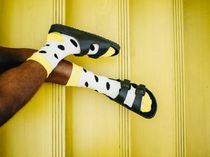Putting a bold foot forward in October of 2017 during Paris Fashion Week, Balenciaga debuted its equally unexpected and controversial footwear collaboration with Crocs, offering consumers the popular Crocs look and feel, but with a signature Balenciaga twist: a 13 centimeter platform and shoe charms—or Jibbitz—bearing the Spanish brand's totem logo.
In 2018, while their Spring/Summer 2019 collections strut down runways around the world, up-and-coming and esteemed fashion houses alike including Preen, Marine Serre, Chloé, Gucci, Calvin Klein, Prabal Gurung and more simultaneously hopped on the "ugly fashion" bandwagon, throwing the fashion industry off-kilter and headed for the unknown. In bubblegum-pink cargo pants by Prabal Gurung, wetsuit-inspired ensembles by Raf Simons for Calvin Klein, Gucci's handbags offering so-called "childhood nostalgia" and Chloé's reimagined early-2000's fringe vests and bedazzled belts, designers continue to prove that prioritizing practicality over what is considered conventionally pretty is merely a sign of the times.
It has been noted that over the last several seasons, both large and small brands have been chasing the ever-quickening fashion industry that no longer follows conventionality, but rather seeks to capture the hearts of those growing up and learning to survive in an era of norm-shattering socio-cultural and political revolution. Fifteen seconds of fame is no longer the too-short amount of time designers, celebrities and regular people alike feel they need to capitalize on, but instead, it is now the five seconds of attention that is most sought after. It is often only the horrifically styled, shockingly printed or putridly patterned that has the capacity to do so, but this has not, however, halted swarms of consumers from pinching pennies to purchase the latest in "ugly" high fashion, and has alternatively opened a new door for an entirely new market made up of those interested in PVC shoes, enchanted by streetwear from decades gone by, and seeking the liberation and self-expression that comes from looking good while also feeling good comfortable: Millennials and Gen-Z-ers.
Often attributed to—or blamed for—the rise in ugly fashion's popularity, athleisure, or the combination or restyling of traditionally athletic wear with or into an ensemble that can be worn at the office or out for lunch with friends, has paved a new path for designers and consumers alike. Instead of opting for silks, linens and other natural textiles that easily wrinkle and often require maintenance beyond a quick spin through the washer and dryer, younger generations are donning '80s-inspired, nylon neon bike shorts, bumbags and chunky white sneakers for both comfort and utility. This combination has proven profitable for a variety of brands, including Birkenstock, who have seen monumental sales increases over the last few years, and has even inspired somewhat of a cult following among designers as well as the public in the process.
"I'm more inspired by things which I don't like...nothing is so boring as something beautiful. I prefer ugly things, I prefer things which are surprising," Belgian designer Dries van Noten quipped in 2012 at the French Institute Alliance Française. While giving the same talk, Dries also spoke about no longer wanting to live in "the old world", where prêt-à-porter was the identifying mark of one's personal sensibilities. Now, he believes that fast-fashion is good, and says, "Why not?" to combining inexpensive pieces from fast-fashion hubs like Zara or H&M with vintage or designer accents. Other fashion houses appear to agree with Dries, and are seemingly following suit, creating fashion experiences for both the Instagram street-style stars of today, as well as the celebrity influencers with their fingers on the pulse of fashion. Virgil Abloh's Off-White, for example, personifies the industry's changing outlook on the role of streetwear in high fashion, with screen-printed cotton hoodies and sweatshirts and sneakers that can exceed $1000 each.
As this nearly $300-billion-dollar trend continues, however, some fashion houses and designers continue to repel themselves away from the growing model of luxury brands turning casual, or rooting their collections in streetwear—urban youth culture exemplified primarily through nylon, spandex-cotton blends, jersey knits, and vinyl fabrics with stretch. These include London-based designer Nasir Mazhar, Kerby Jean-Raymond of Pyer Moss, and Givenchy creative director Clare Waight Keller.
"Givenchy sells trackies and sweaters and T-shirts, but Givenchy would die if they called it streetwear!" Mazhar told journalist Ted Stansfield in 2016. Although most fashion houses continue to adapt themselves to fluctuating markets and popular trends by incorporating more casual, ready-to-wear garments and accessories, they are also not about to be abandoning the luxurious cornerstones of each of their labels, regardless of ugly fashion's attempt at masquerading as couture.
In an era where a printed T-shirt or designer brick is valued more than the craftsmanship and meticulous curation of garments from high fashion brands, the question that remains is whether or not fashion houses and designers alike will continue to fulfill a small proportion of the population's comfort-seeking demands, or if the industry as a whole will reclaim the idea that fashion and comfort can co-exist outside the context of spandex joggers and ironic hoodies. Velcro sandal-sneaker hybrids be damned.






 The minimum wage is not a living wage.
StableDiffusion
The minimum wage is not a living wage.
StableDiffusion
 influential nations
StableDiffusion
influential nations
StableDiffusion












